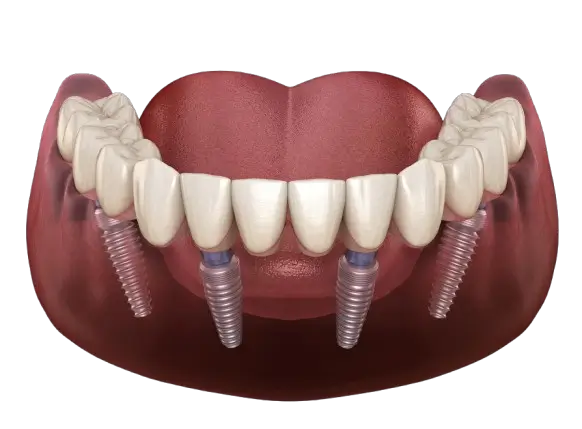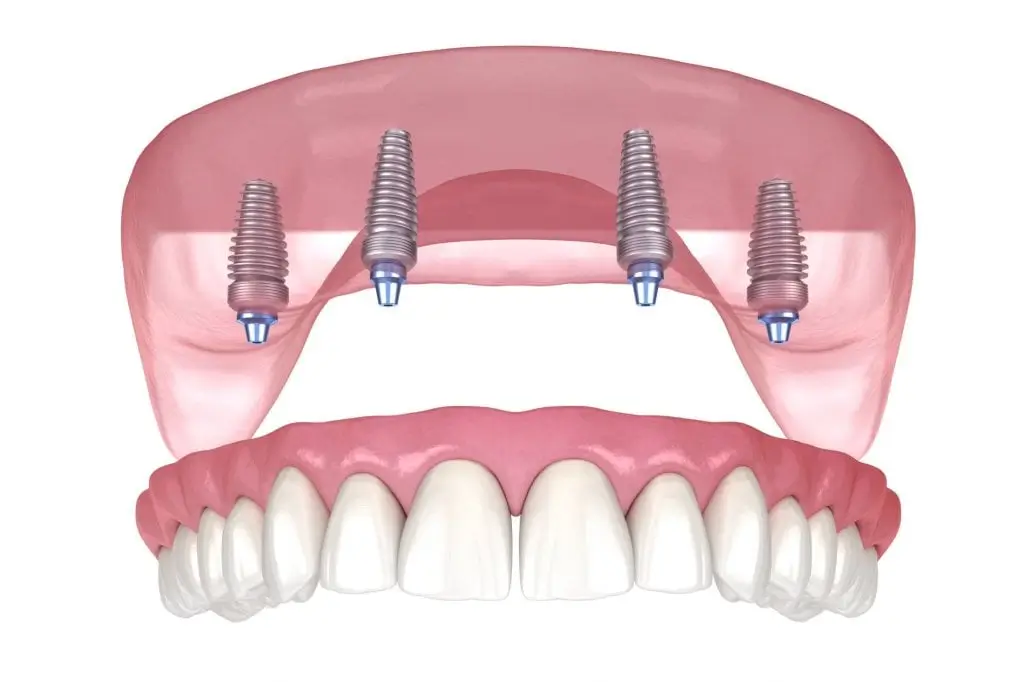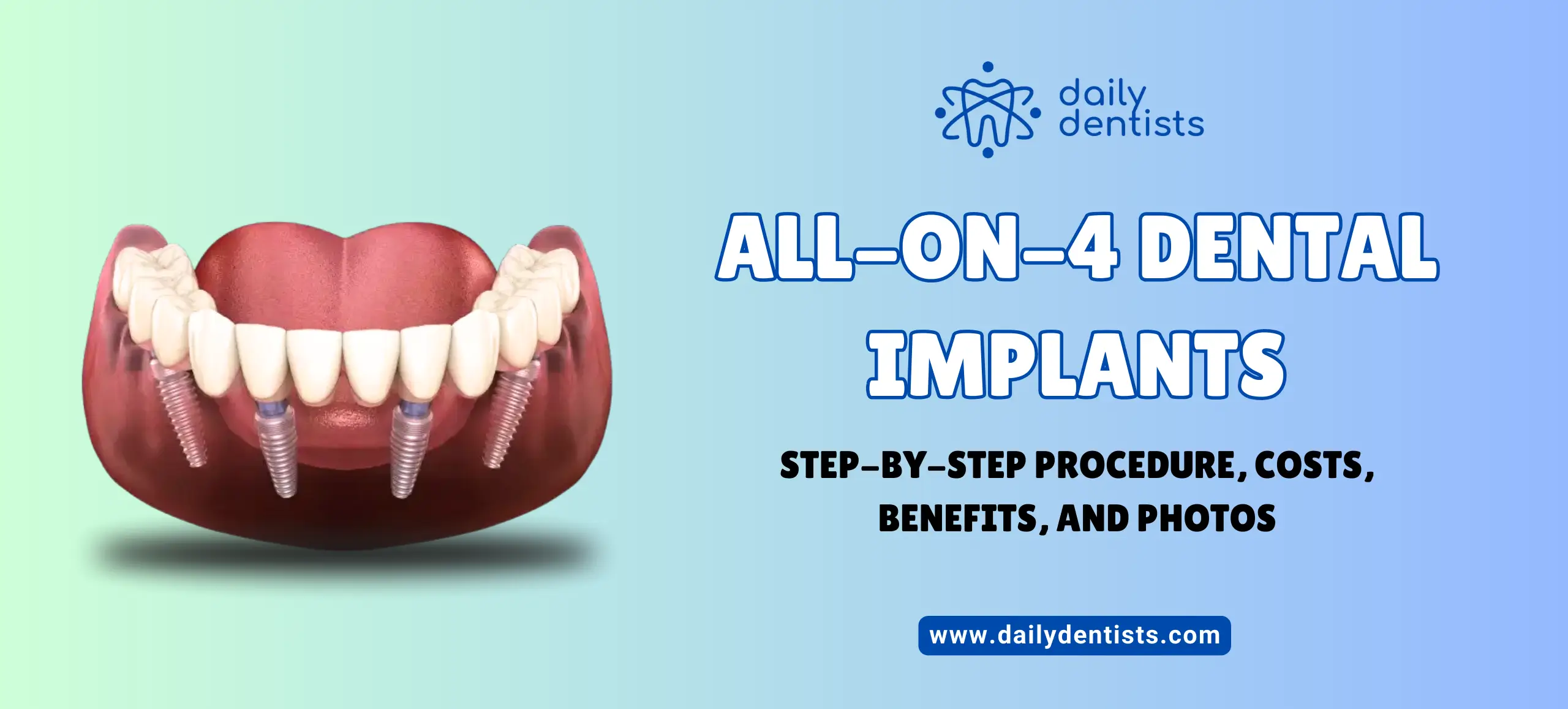All-on-4 dental implants offer a reliable solution for people who’ve lost most or all of their teeth. This technique gives a full set of new teeth with just four implants, making it a faster and less invasive option compared to traditional implants. In this article, we’ll dive into the All-on-4 procedure, cost, potential issues, and show you some photos to illustrate the results.
All-On-4 Dental Implants Video
What Is All-On-4 Dental Implants?

All-on-4 dental implants are a revolutionary technique for people who need full arch replacement, meaning the entire upper or lower set of teeth is replaced. Unlike traditional implants, which use one implant per tooth, the All-on-4 method requires only four implants to secure a full set of teeth. These implants act as anchors for a prosthetic bridge, holding it firmly in place.
The procedure is designed to restore the function and appearance of natural teeth. It’s often used for patients with significant tooth loss or severe dental issues that make traditional dentures uncomfortable or unreliable. For many, All-on-4 implants are life-changing. They offer a permanent solution to restore not just your smile but also your confidence and ability to eat without worry.
All-On-4 Dental Implants Step By Step Procedure
- Consultation and Planning:
The first step is an in-depth consultation with your dentist. They will evaluate your oral health and take x-rays or a CT scan to assess your bone structure. It’s essential to have enough bone density in your jaw to support the implants. Your dentist will also discuss your medical history to ensure you’re a suitable candidate. - Preparation and Tooth Extraction (if needed):
If any remaining teeth need to be removed, this will be done during the procedure. In some cases, bone grafting might be necessary if there’s not enough bone density. This step ensures that your jaw can support the implants. - Implant Placement:
The dentist strategically places four titanium implants in your jawbone. Two are placed near the front of the mouth, and two are angled at the back to maximize bone contact. This strategic placement helps avoid areas with low bone density and secures the entire arch. - Temporary Prosthesis:
Once the implants are in place, a temporary prosthetic is attached to them. This set of teeth looks and functions like natural teeth but is lighter than the final prosthesis. You’ll wear these temporary teeth for several months while your implants fuse with your jawbone. - Healing and Osseointegration:
Over the next three to six months, your jawbone will bond with the titanium implants through a process called osseointegration. During this healing phase, it’s important to follow your dentist’s advice to avoid disturbing the implants. - Final Prosthesis:
After the implants have fully integrated, your dentist will replace the temporary prosthesis with a permanent set of custom-made teeth. These will look, feel, and function like natural teeth, providing a long-lasting solution.
How Much Do All-On-4 Dental Implants Cost?
The cost of All-on-4 dental implants varies based on several factors, including the clinic’s location, the dentist’s expertise, and the specific needs of the patient. On average, patients in the US can expect to pay between $20,000 to $30,000 per arch (upper or lower). This price typically includes consultations, implant placement, temporary teeth, and the final prosthesis.
However, certain factors may increase the cost:
- Bone Grafting: If your jawbone requires additional work, this can increase the overall cost.
- Sedation Options: Some patients may require general anesthesia or other sedation options, adding to the total expense.
- Location: Dental clinics in metropolitan areas may charge more than those in smaller towns.
What Are the Problems With All-On-4 Dental Implants?
While All-on-4 implants offer a reliable solution, there are some potential downsides and risks to consider:
- Implant Failure:
Though rare, implants can fail. This can happen due to poor bone integration, infection, or excessive force on the implants. - Bone Loss:
The implants are designed to prevent further bone loss, but if placed in weak areas, some bone degradation could still occur over time. - Temporary Speech Issues:
After the procedure, some patients may experience difficulty speaking or adjusting to their new teeth. This usually improves as they get used to the implants. - Cost:
The cost can be prohibitive for many people. Some dental insurance plans don’t cover the full cost of implants, leaving patients with significant out-of-pocket expenses. - Sensation Loss:
Unlike natural teeth, implants don’t have nerves. This means you won’t have the same sensations when biting or chewing, which can feel strange at first.
All-On-4 Dental Implants Photos
Seeing is believing, and looking at real-life examples of All-on-4 dental implants can help you visualize the potential results. Below are some photos showing the transformation that patients undergo:
Before and After of All-On-4 Dental Implants Photos:
In the “before” image, you’ll notice missing or severely damaged teeth, along with the challenges of tooth loss. In the “after” image, the patient’s smile is fully restored with a new set of secure, natural-looking teeth.


Close-up of All-On-4 Implants:
This shows the precise placement of the four implants in the jaw. The angled positioning of the back implants provides stability without the need for bone grafting in most cases.

These transformations show just how powerful All-on-4 implants can be in restoring not just the function but also the aesthetics of your smile.
Conclusion
All-on-4 dental implants offer a permanent, natural-looking solution for those who’ve experienced tooth loss. The procedure provides a full arch of teeth using just four implants, making it a quicker and less invasive option than traditional methods. While the cost may seem steep, the long-term benefits of having a strong, stable, and aesthetically pleasing smile make it worth the investment for many people.
However, like any dental procedure, All-on-4 implants come with some risks, including implant failure and the possibility of bone loss. But for the majority of patients, the advantages far outweigh the potential downsides. If you’re considering this procedure, a thorough consultation with your dentist will help you decide if All-on-4 is the right option for your dental needs.
Related Articles
- Reasons Not To Get Dental Implants
- Can A Dental Bridge Be Done In One Day?
- How To Remove Coffee Stains From Teeth Naturally

